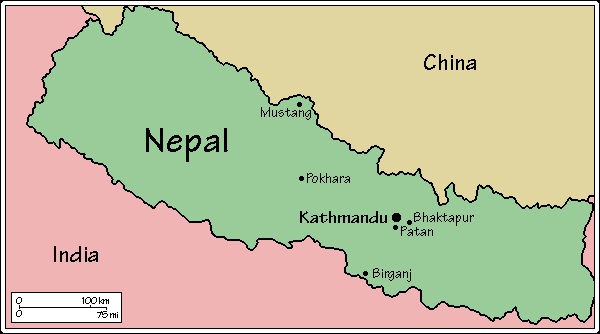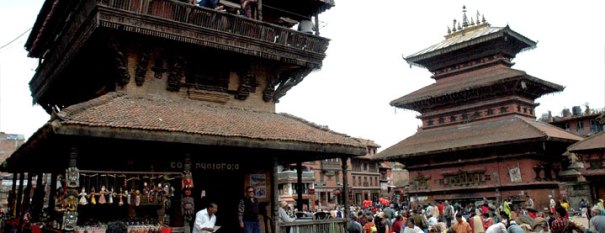What Do You Know about Nepal?
Nepal is portless. It has no ports. It’s completely landlocked with India on the southwest and China on the northeast. But you have to go through the mountains to get to Tibet (China) and India is way down the mountains at a much lower elevation. It’s about the size of Arkansas. Arkansas? Doesn’t help you much. Anyway, it’s not too big. And it’s high. It’s so high, they have the tallest mountain. Mount Everest? 30,000 feet. That sounds higher than 9,000 meters, doesn’t it? And it has other ones that are pretty tall as well but not so famous.
They call them the Himalayan range. Or the Himalayas, for short.

Do they have a King?
In 1990, King Birendra introduced some democracy to Nepal although he didn’t want to. In 2006, King Gyanendra gave up the throne somewhat and let the Parliament have some say. They voted to reduce the king’s power, not a surprise there. Then in 2008, they abolished the monarchy entirely. So, No more king.

If you go back into the past, you might meet Prince Siddhartha Gautama looking for enlightenment. Maybe you know of him as Buddha. Buddha from Nepal? True story. Then Buddhism gave way to Hinduism. That did come up from India around the 12th century. There were some dynasties before the Malla kings really got Nepal going over the next 500 years.
In the middle of the 1700’s, King Prithvi Narayan Shah shows up. He found India too hot, in more ways that one. The Moghul ran him out. And once you get to Nepal, there is really nowhere else to run, so he stopped running and took over. I guess Nepal wasn’t big enough to suit him so they expanded it to border Kashmir and India.
They had to deal with the British now as it was 1800. And all trade had to be through the British East India Company. It took until 1920 for Britain to recognize that Nepal was its own country. The Rana family was running the show under the title of prime minister. But in 1950 the king took over and turned it back into a monarchy. But this time “a constitutional monarchy”. Mahendra Bir Bikram Shah became king. A few years later he died rather suddenly in 1972. Heart attack, they say. So Prince Birendra took over then. He was 26.

Will Nepal go Red?
Jumping ahead to 1990, a pro-democracy movement said that King Birendra had to let some political parties get organized and have some elections. The liberal Nepali Congress Party won the elections barely squeezing out the Communist party. Well, the communists did not take losing too well and tried to overthrow everybody else. They were big in the countryside in 1996.

Prince kills royal family, then self in Nepal
In 2001, all hell broke loose with Prince Dipendra shooting King Birendra. Why did he kill the old man? It seems nobody liked his new bride was the story. He was really mad about it and shot up the entire royal family including his own mom! Then he shot himself rather than explain his actions. Prince Gyanendra, his uncle, had to pick up the pieces and take over the king job.

King Takes Over
King Gyanendra decided it was time to clean house. There were few royals left to argue with him and he shut down the whole government in 2002. He said they were corrupt and ineffective. He declared a state of emergency and ordered the army to crack down on the Maoist guerrillas. The rebels did not take this lying down and fought back, losing hundreds of lives in the process. In 2003, the Maoist rebels blockaded Kathmandu for about a week. No food or fuel went into the capital.
King Gyanendra fired everybody and took complete control now. But by 2006, everybody was sick of this and started up pro-democracy protests. ‘What about a prime minister?’ offered King Gyanendra. Nope. They wanted the whole deal. And a new constitution, as well.
Finally, King Gyanendra agreed to bring back the Parliament. The new parliament quickly moved to diminish the king’s powers. He had to see that coming. Girija Prasad Koirala became prime minister. They declared Nepal a secular nation and stripped the king of his authority over the military. So everyone was happy now. Except the king, of course.

The Maoist rebels and the government signed a peace agreement in 2006. I mean, over the previous decade, 12,000 people had died. In 2007, the Maoists got in on the government only to quit later that year. Not enough progress, they said. Some people are never happy. A couple months later, they reconsidered and rejoined, when Parliament voted to completely abolish the monarchy and make the place a federal democratic republic.
In 2008, they got a new constitution and the Maoist rebels ended up with half the elected seats. This beat fighting in the countryside. Well, 240 years was enough ruling for the monarchy and King Gyanendra decided to clear out of the Narayanhiti Palace and quit the king business entirely. Just call me a commoner, he said and so they did.
As you might guess, things went back and forth between the communists and everybody else. Finally, the Maoists said they would give up and return the private property they had seized from their opponents.
It went on and on until 2011, when Parliament finally agreed on a prime minister: Jhalanath Khanal. He was the chairman of the Communist Party. It really didn’t stop there. The rival parties agreed to draft a new constitution and address questions about the 19,000 former Maoists who are currently living in camps throughout the country.

In Nepal, there are now three genders. This causes trouble with taking a census but shows that the government is trying to make everybody happy whether they are communist or whatever.

2012 arrives with no new constitution. Prime Minister Baburam Bhattarai announced that he would hold elections in November 2012 for a new legislature. In his announcement, Bhattarai said, “Political consensus is still needed to move ahead. Let us learn from mistakes and move ahead.”
The Supreme Court of Nepal said, “Hey, where is that new constitution you promised?” You didn’t know they had a Supreme Court, did you? Well, they do, and they wanted to see the new, new constitution pretty darn quick. About 30 million other Nepalese echoed the same. Well, enough about the wild politics of Nepal, huh?

Basic Stuff about Nepal
The capital and largest city is Kathmandu and over a million people call it home. There are a couple other big cities like Biratnagar and Lalitpur, but nobody talks about them much. They speak English a lot in Nepal and they spend Nepalese rupees. Got the name from India. Among the many ethnic/racial groups, most people are Hindu with some Buddhists added to the mix. People only make about $1,200 a year. That’s $100 a month. And unemployment is at 45%.
They grow rice, corn, wheat, sugarcane, and root crops. There are only about 11 million in the work force and most of them are unskilled labor. The economy is really mostly farming with little industry and some service jobs.
Tourism is big there as you might guess. They also make carpets which they export. Their biggest natural resource is the scenic beauty.
They have mobile phones, and some televisions tuned to the one TV station. They do have the internet there with many Internet Service Providers and avid internet users. The best way to go there is to fly. It’s way high, remember?

